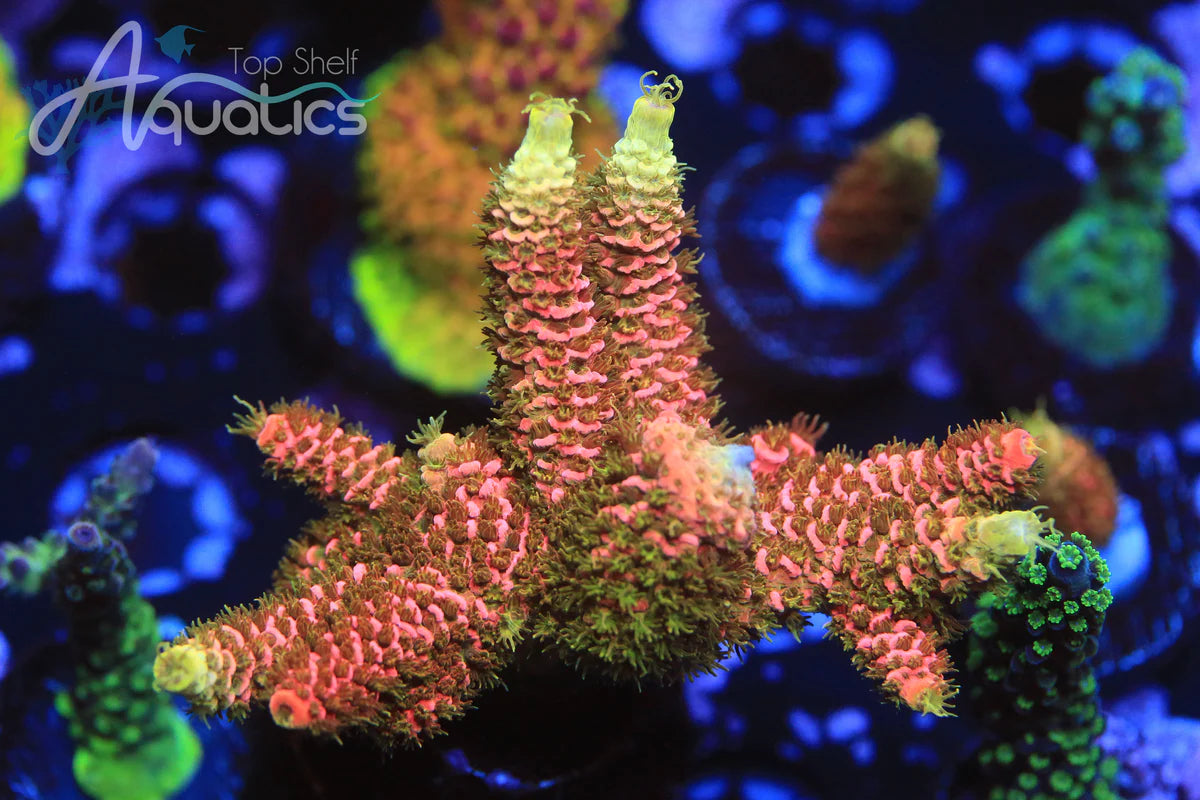When you embark on setting up the perfect reef aquarium, you will want to incorporate coral. You might, however, not realize there are different types of coral with their own characteristics and needs. The two main categories of coral are hard and soft corals. Soft corals lack an internal skeleton. They can sway in the water due to their soft, flexible structure.
On the other hand, hard corals are the most visible reef-building corals on the coral reef. Their hard skeletons create the foundation of coral reefs. There are two main types of hard corals: LPS and SPS.
Main Difference Between SPS and LPS Coral
What is SPS coral and LPS coral? Hard corals are broken down into SPS (small polyp stony corals) and LPS (large polyp stony corals). They can grow into a singular polyp coral or multi polyp corals called colonies. Both LPS and SPS skeletal structures are composed of a calcium carbonate skeleton. They grow, reproduce and build their own skeleton, and both have polyps on top of their hard skeleton. While both SPS and LPS coral share many similarities, they also have many differences that are important to know when setting up an aquarium.
Appearance
The easiest way to differentiate between SPS and LPS coral is their appearance. LPS is much larger than SPS. It has a large skeleton with soft polyps on top. In contrast, SPS coral has smaller polyps that look similar to branches or flowery dots all over the skeleton.
Flow Requirements
LPS and SPS coral have different water flow requirements. SPS coral's smaller polyps are not as adept at catching minerals as the LPS variety. Stronger water flow delivers nutrients and essential reef building elements to the polyp. While removing any waste material. On the other hand, LPS coral thrive in a low water and flow environment. Its polyps will sway in the water but can retract if disturbed by excess water movement.
Lighting Requirements
LPS corals are often best suited to the mid to lower portion of an aquarium. While most, SPS require a high light environment, resting at the top of an aquarium.
How to Care for SPS Corals
Caring for LPS coral is simpler than SPS. Nonetheless, advanced aquarium hobbyists delight in delicate SPS. Caring for small polyp stony corals can be successful when following these guidelines.
- Ensure a high water flow. The water flow moves nutrients throughout the tank, helping SPS gain essential nutrients.
- Keep tank water clean. SPS corals require excellent water quality.
- Use proper high lighting sources. Popular choices are LED, T5s and halide lighting. Some hobbyists use a combination of light sources, but others find success with one type.
- Just like other organisms, coral requires nutrients so it’s best to ensure these are prevalent. The best nutrient is fish excrement, which contains nitrates and phosphates for the SPS. Bacteria and algae will eat the excess nitrates and phosphates.
- Perform routine tank cleanings to ensure a healthy aquarium.
Fragging SPS Coral
Coral grows in what is known as mother colonies. In order to create a new colony, small pieces must be removed. This is known as "fragging". When learning how to frag SPS coral, it is important to have the right tools. First, you will need bone cutters or a rotary device such as a dremel, coral glue and a frag plug.
- Although coral can be broken with fingers, it is not advisable. Fingers may leave tissue behind or tear it away, leaving a damaged frag or mother colony. Instead, cut the area that you want to frag with bone cutters.
- Soak the frag plug in the tank or rodi water beforehand to prevent air bubbles being trapped on the surface of the plug.
- Attach the frag to the plug with coral glue.
- Place the coral back into the aquarium away from tank inhabitants that may knock over the newly fragged coral. Snails, urchins and hermit crabs are known offenders.
FAQs
- How do I know if my SPS is getting the right amount of light? Photosynthetically available radiation (PAR) measures aquarium light. There are par meters for purchase that help measure an aquarium's PAR. SPS prefers a range of 250-450 par.
- How do I color up SPS corals? PAR impacts the color of SPS coral. Ensuring you have the best level of light will optimize your coral colorization. Different elements can also affect the color. Potassium brings out blue hues. Iron, on the other hand, brings out greens.
- How fast do SPS corals grow? The conditions of your tank affect coral growth rate, but traditionally, SPS will grow faster with stable parameters.
- Are some SPS species easier to keep than others? Yes! Although all SPS are delicate, Acropora are generally harder to keep. Beginners could try Montipora, Pocillopora or Seriotoporas varieties.
- Can you have soft and hard coral in the same aquarium? LPS and soft corals generally grow well together. The larger your tank, the easier it is to integrate all species.
- Can LPS and SPS coral live in the same aquarium? LPS and SPS can coexist in an aquarium. It is important to note, some species of LPS can be aggressive. So be cautious and research individual species for their aggressiveness.
Other Tips and Tricks
- Stores will not have the same lighting levels as your new aquarium. It is a good idea to learn how to acclimate SPS corals. Keep new coral on a frag rock or sand bed until it is accustomed to its new home.
- Hermit crabs or turbo snails are excellent cleaners if you have an overgrowth of algae in your tank.
- When shopping for fish, make sure they are reef-compatible. Some fish nibble and harm corals.
Let Top Shelf Aquatics Be Your Resource for All Things Coral
Top Shelf Aquatics has focused on sustainable aquaculture since 2011. Our passion for coral and marine fish has translated into the best livestock in the industry. Strict quarantine processes and water filtration ensure customers receive healthy livestock to create their beautiful aquariums.
Join our VIP Club to get the latest promotions, information and event invitations. For any other questions or information, contact us. We are always happy to help share our expertise so that everyone can have their own healthy piece of ocean.
| Join Our VIP Club |
Properly caring for an aquarium takes a lot of work, but there are some steps that will make the process easier. Saltwater tanks require special tools and processes to ensure it's providing a healthy environment for your marine fish and corals. Use these helpful tips and tricks to get you started on the right foot with setting up and maintaining your saltwater aquarium.
General Tips
Before you get your tank, if you haven't done so yet, it's important to know a few of the basics. Taking care of a saltwater tank requires different maintenance than that of a freshwater tank.
The temperature needs to be kept near or at 78 degree Fahrenheit. Even a few degrees difference can be the deciding factor between livestock thriving, so it's important to keep an eye on this.
The salinity is essentially how much salt is in the water and is measured in parts per 1,000 units of water. You need this to be about 34 to 36 parts per 1,000 units of water. A refractometer or hydrometer can be used to measure it.
To help make things go smoothly, it's important to schedule all the tasks you'll need to do. We'll go into more details later, but this includes adding heated freshwater, checking the salinity, changing out the water, making sure your filter is not clogged up, making the saltwater, scrubbing the algae, and checking the water quality and temperature. This doesn't include the specific care your fish will require like quarantining and feeding.
Frequently Asked Questions
Is it easy to maintain a saltwater tank?
There are many steps to take to properly care for a saltwater tank and livestock, however, with a scheduled routine, it can become a relatively easy process. It's not ideal for someone who is frequently away from home or who simply doesn't have the time to care for it.
What size tank should I get if I'm a beginner?
While there are many size tanks you can choose from, a 50- to 90-gallon tank is better for someone who has no experience caring for a saltwater tank.
Is it better to get an acrylic or a glass tank?
This really comes down to your personal preference. Glass tanks have better clarity and are resistant to scratching compared to acrylic which is easier to clean and prone to scratching.
What types of parts do I need to get started?
This is a rather long list, but most of the parts will last for years, so once you buy them, you won't need to replace them again for a while.
- Tank
- Stand
- Sump
- Return pump
- Protein skimmer
- External filter
- Circulation pump or powerhead
- Heater and thermometer
- RO system
- Lighting
- Substrate
- Live or dry rock
- Salt mix, additives and hydrometer
Step-By-Step Guide
As mentioned earlier, it's best to set up a schedule to ensure maintenance is performed at the proper times. Because there are tasks that need to be completed on a daily, weekly and monthly basis, here are some lists to help you get started.
Daily
- Check the salinity to make sure the salt content is not too high. If it is, you can top it off with fresh water.
- Check the water chemistry. As time goes by, you won't have to do this as much, but when you first set up your tank, it's a must.
- Check the water temperature.
Weekly
- Perform a 20% water change weekly.
- Make new saltwater.
- Maintain your filtration system.
- Scrub algae with a scrubber.
Tips to Help Things Go Smoothly
Once you get in the swing of things and your fish are thriving, you may be on the lookout for ways to make life easier. There are a few things you can do to save time that aren't exactly shortcuts but work effectively to make the task of caring for your saltwater tank simpler.
The first is making sure you have an effective filtration system. This is important because it means you don't have to change out the water in your tank quite so often.
A protein skimmer is also a handy tool to use. As the name implies, it removes the protein from the water and deposits it in a cup which you can dispose of later.
While there is no truly quick way to clean a tank, you can combine this task with changing out the water. This will help you do both at once, which will speed things along.
Let Top Shelf Aquatics Be Your Go-To Source for Saltwater Aquarium Equipment
Whether you're new to saltwater tanks or have been maintaining one for years, Top Shelf Aquatics can help you with everything from equipment to recommendations for stress-free maintenance.
From livestock to water filtration systems and more, we ensure quality and the highest standards of excellence in every item that leaves our store. Join our VIP Club today for more information, and we'll text you with exclusive promotions, discounts and upcoming events.

